

Introduction to grammar. Introduction to grammar. Introduction to grammar. Introduction to grammar. Introduction to grammar. Creating Paper Slide Videos. Simple zigzag book. Introduction to grammar. Introduction to grammar. Introduction to grammar. How to get started as an online teacher of English. Have you thought about teaching English online? Emma Segev gives some practical tips and useful websites for getting started in one of our top five articles of all time, illustrated by artist Jamie Johnson. When I first started teaching in 2004, I was sceptical about the effectiveness of online teaching, but since then I have accumulated a lot of experience. I'd like to share with you a few things I've learned along the way. Getting started Contrary to popular opinion, I recommend starting your online teaching career by working for an established company.
When choosing an established company, you'll need to find one that has students looking for lessons in your working hours (your time zone). Creating a blog In the last few years, I've created more of my own materials, usually on the back of envelopes, in notebooks, word files and on scraps of paper. Teaching online - tech tools and the tutor's role. About the webinar The British Council is committed to supporting the use of technology for the continuation of education in a crisis.
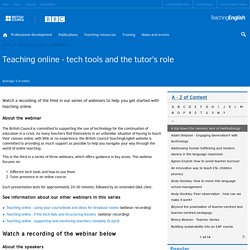
As many teachers find themselves in an unfamiliar situation of having to teach their classes online, with little or no experience, the British Council TeachingEnglish website is committed to providing as much support as possible to help you navigate your way through the world of online teaching. This is the third in a series of three webinars, which offers guidance in key areas. This webinar focuses on: Different tech tools and how to use them Tutor presence in an online course Each presentation lasts for approximately 20-30 minutes, followed by an extended Q&A clinic. How to Write a Lesson Plan: 5 Secrets of Writing Fantastic Lesson Plans. Ideas for using the coursebook creatively. Here is the second extract from the latest British Council publication 'Creativity in the English Language classroom' edited by Alan Maley and Nik Peachey.
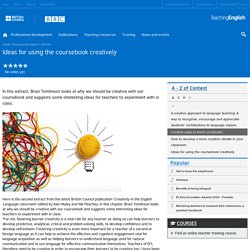
Fifteen ways to adapt your textbook so your students aren't bored to death. Unfortunately, teachers may only be given the textbook without any professional development or additional curriculum resources. It can be challenging, especially for newer teachers, to figure out how to use the textbook to meet the needs of culturally and linguistically diverse students who may be at different levels of English proficiency. It can also be difficult if the textbook is outdated or not well-designed in terms of instructional practice. Textbooks do have some advantages. They can provide a guide for effective language teaching, contain helpful models, save teachers time, and are usually leveled and aligned to standards. However, they can also present a danger when they are viewed (by teachers, administrators, or districts) as the “only” curriculum or one that must be followed precisely.
Rachael Roberts - Planning for differentiation. About the webinar The session will start by looking at some of the ways in which learners can differ from each other - needs, interests and abilities.
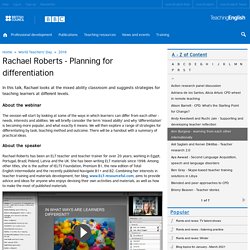
We will briefly consider the term 'mixed ability' and why 'differentiation' is becoming more popular, and what exactly it means. Group work v. whole-class activities. But group work may not always be the best option. There will be a time and a place for whole-class activities in the English language classroom, just as there's a time and a place for group and pair work. In praise of group work In praise of whole-class discussion Tact and sensitivity Repertoire Variety adds spice to the classroom In praise of group work Group work came into the standard EFL teaching repertoire with communicative methodologies in the 1970s. At that time, studies of contemporary foreign language classes revealed that as much as 80% of lesson time consisted of the teacher talking to (at) the students.
In a class of, say, 30 students, it is evident that the learner hardly got a chance to practise the language. Writing activities. Kids and writing. In the classroom there are many ways of using these writing activities to help children practise their English whilst developing their creativity and imagination.
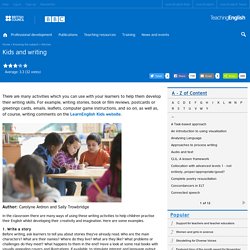
Here are some examples. 1. Write a story Before writing, ask learners to tell you about stories they've already read. Who are the main characters? Product and process writing: A comparison. The best practice in any situation will depend on the type of student, the text type being studied, the school system and many other factors.

Thus, this article cannot prescribe a system for the teaching of writing that is optimal for all teaching situations. Rather, I hope to describe and contrast two popular, yet very different, approaches and examine how both can be used in the classroom. Teaching speaking skills 1. While it is a bit of an exaggeration, students clearly feel that classroom-based speaking practice does not prepare them for the real world. Why do students so often highlight listening and speaking as their biggest problems?
Partly because of the demands of listening and speaking and partly because of the way speaking is often taught. It usually consists of language practice activities (discussions, information-gap activities etc.) or is used to practise a specific grammar point. Neither teaches patterns of real interaction. Kids and speaking. A reason to speak Make sure that the children have a reason for speaking, for example, they need to talk to their partner to complete a picture or to find information in order to make a graph. Think about the questions you ask in class. If you ask ‘Is this a pencil?’ Children can only respond either ‘yes’ or ‘no’. And of course you already know it’s a pencil so the question isn’t real. Personalised speaking. What our students bring to the learning environment is our richest resource.
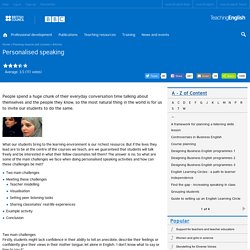
But if the lives they lead are to be at the centre of the courses we teach, are we guaranteed that students will talk freely and be interested in what their fellow classmates tell them? The answer is no. So what are some of the main challenges we face when doing personalised speaking activities and how can these challenges be met? Two main challenges Meeting these challenges Teacher modelling Visualisation Setting peer listening tasks Sharing classmates’ real-life experiences Example activity Conclusion Two main challengesFirstly, students might lack confidence in their ability to tell an anecdote, describe their feelings or confidently give their views in their mother tongue, let alone in English: 'I don’t know what to say or how to say it.' Secondly, classes are made up of students who are thrown together by circumstance.
TeachingEnglish. The magic of story time. Where the 'magic' liesStories provide shared contexts for rich, natural language development from a very young age, and throughout the primary years.
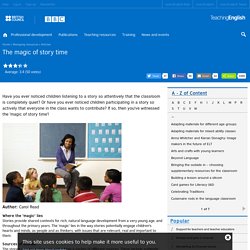
The 'magic' lies in the way stories potentially engage children's hearts and minds, as people and as thinkers, with issues that are relevant, real and important to them. Sources of storiesThe stories we use in class may come from a variety of different sources. These include authentic picture books from the English-speaking world, specially written children's readers, course books, educational and other sites on the internet, or English versions of local cultural tales and fables. The important thing is not so much the source of the stories but the appeal and interest they have for the children themselves. Analysing Language. Checking understanding generally follows the isolation of new language which has been presented in context, analysed and fully explained.

It is this analysis and explanation stage which is the focus here. A framework for analysis Form and phonology Function and meaning Register and appropriacy Post analysis A framework for analysis The teacher may present language inductively through a text, a situation, through a task, or simply asks learners to 'notice' lexis. Alternatively a deductive approach may be used whereby the learners are given the rules and asked to apply them in using the language. Course planning. Pre-service teacher training courses typically focus on the detailed planning of a 40 minute or 60 minute lesson and don’t focus attention on how to go about planning a much longer scheme of work.

This is also an important area to consider though, because most teachers are involved in teaching courses, which may typically last anywhere between 30 and 120 hours. The aim of this article is to share some of the conclusions of a recent project I was part of, with the hope that it might enable other teachers to plan a little faster too! Why do we plan our lessons? Reading practice football world cup worksheet v2. Student worksheet 2. Film reviews. Introduction: In this lesson learners will revise some film review vocabulary through pair-work discussions.
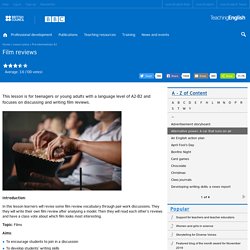
They they will write their own film review after analysing a model. Then they will read each other’s reviews and have a class vote about which film looks most interesting. Topic: Films. Get to know the neighbours. TE_blank_template. Introduction to grammar. Introduction to grammar. Introduction to grammar. Introduction to grammar. Prepare a lesson. Introduction to grammar. Introduction to grammar. Katherine Bilsborough: Lesson plans – less is more. You can travel without a list of course but you will avoid a few problems if you spend a bit of time planning – not a whole week though. That would be silly. A few minutes should be enough. Introduction to grammar. Introduction to grammar. Introduction to grammar. Pre-teaching. Introduction to grammar. Introduction to grammar. Introduction to grammar. Password protected padlet. Introduction to grammar.
Introduction to grammar. M.Ed. in Differentiation - Sample Lesson. Reconcilable Differences? Standards-Based Teaching and Differentiation. Understanding Differentiated Instruction: Building a Foundation for Leadership. Total physical response - TPR.
Where is it from? How can I use it in class? When should I use it? Why should I use it in the classroom? A few useful variations Are there any disadvantages with using TPR? Where is it from? TPR stands for Total Physical Response and was created by Dr. How can I use it in class? In the classroom the teacher plays the role of parent. It is more effective if the students are standing in a circle around the teacher and you can even encourage them to walk around as they do the action. When should I use it? Bradley - Scaffolding Academic Learning for Second Language Learners. The Internet TESL Journal Karen Sue Bradley & Jack Alden Bradleykfksb00 [at] tamuk.eduTexas A&M University (Kingsville, Texas, USA) IATEFL 2018: Safe Speaking Environments - What? Why? How? Published 9 April 2018.
Motivating speaking activities for lower levels. Motivating the unmotivated. Motivating teenagers. I will link three practical classroom activities to the ideas of American Psychologist Carl Rogers. Equal opportunity and diversity: The handbook for teachers of English. Identifying and working with dyslexic students. Teaching English to learners with Special Educational Needs (SENs) – Myths and realities.
Reflective teaching: Exploring our own classroom practice. By collecting information about what goes on in our classroom, and by analysing and evaluating this information, we identify and explore our own practices and underlying beliefs. Moodle. Moodle. TPR. TPR means Total Physical Response. It is an approach to teaching language based on the idea that if you have to do something physical in response to language, then learning is more meaningful, and you learn faster. ExampleThe learners are looking at action verbs. The teacher says 'Jump! ' Different ways to show understanding. Introduction to grammar. Introduction to grammar. Introduction to grammar. Password protected padlet. Microsoft Word - TfS_LandT_wk_3_different_ways_grouping_learners_transcript.docx. Introduction to grammar. Microsoft Word - 3.9 commentary formatted.docx.
Microsoft Word - 3.9 lesson materials formatted.docx. Introduction to grammar. Teaching Speaking - Unit 1: Introductions. UL motivating speaking activities steps. UL motivating speaking activities task. Giving praise to learners. Giving praise to learners. Giving praise to learners. UL Building rapport. UL Getting to know you activities.
UL Online journalling tools. Reflective teaching: Exploring our own classroom practice. What is Differentiated Instruction? Examples and Strategies. English speaking skills practice. Online video for ELT. Homework grids - 3 differentiated levels. Homework grids - 3 differentiated levels. The role of homework. Adapting materials for mixed ability classes. Freeze the writing - A way to make writing tasks a group activity. Creative group writing. Using students' first languages in the classroom.